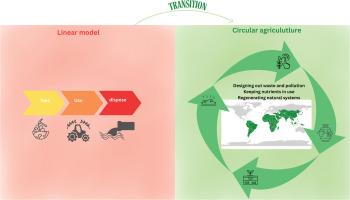从线性系统向循环系统的过渡为全球南方的小农农业提供了可持续的解决方案
Q2 Environmental Science
引用次数: 0
摘要
尽管平均生产率较低,但农业仍然是全球南方经济体的核心。它为许多农村劳动力提供了生计,并在国内生产总值(GDP)中贡献了相当大的份额。小农面临着持续的挑战,包括水资源短缺、能源获取有限和体制支持薄弱。线性的“获取、使用、处置”系统使自然资源枯竭并产生废物,从而加剧了这些压力。本综述综合了2005年至2025年间发表在Web of Science、b谷歌Scholar、Scopus以及粮农组织等国际组织数据库上的150多项研究的见解,以研究循环经济干预措施如何提高小农农业的可持续性。堆肥、蚯蚓堆肥、生物炭应用和黑兵蝇(BSF)生物转化等循环做法已经在小农环境中出现。这些实践中的许多都是在筒仓中实现的,需要在一致的跨农场框架中进行集成。该审查还发现了以前被忽视的再生实践与数字农业工具(如物联网传感器和精确输入系统)之间的跨学科联系。这些方法一起使用,可以帮助小农减少浪费,形成营养循环,提高投入效率和土壤健康。新兴的商业机会包括本地化的堆肥和生物流化床企业、生物炭供应服务以及提供气候智能型产品的农民主导合作社。水培和鱼菜共生等潜力巨大的选择仍然受到基础设施和能源需求的限制,需要局部适应。文献表明,当风险调整后的收益明确时,投资者可以发挥催化作用。因此,环保干预措施必须带来环境影响和财政可行性,以吸引农民参与并吸引资本。为了加速采用,未来的研究和政策应该通过小额信贷计划、同行主导的示范农场和共同制定的政策路线图来解决融资障碍、能力差距和政策错位问题。这篇综述提出,全球南方地区小农农业的环保实践不是可有可无的,而是必不可少的,与传统的线性系统相比,它提供了一条提高资源效率、恢复力和经济可行性的途径。紧迫性在于资源枯竭、环境退化和气候变化的威胁正在加速,如果不加以解决,这些威胁将破坏小农的生计并危及区域粮食安全。本文章由计算机程序翻译,如有差异,请以英文原文为准。

Transitioning from linear to circular systems offers sustainable solutions for smallholder agriculture in the Global South
Agriculture remains central to economies across the Global South despite lower average productivity. It provides livelihoods for much of the rural workforce and contributes a meaningful share of gross domestic product (GDP). Smallholder farmers face persistent challenges that include water scarcity, limited energy access and weak institutional support. These pressures are intensified by linear “take, use, dispose” systems that deplete natural resources and generate waste. This review synthesizes insights from over 150 studies published between 2005 and 2025 in Web of Science, Google Scholar, Scopus, and international organizations such as FAO databases to examine how circular economy (CE) interventions can enhance the sustainability of smallholder agriculture. Circular practices such as composting, vermicomposting, biochar application and Black Soldier Fly (BSF) bioconversion are already emerging in smallholder contexts. Many of these practices are implemented in silos and need integration within a coherent cross farm framework. The review also identifies a previously overlooked interdisciplinary connection between regenerative practices and digital agriculture tools such as IoT sensors and precision input systems. Used together, these approaches help smallholders reduce waste, close nutrient loops and improve input efficiency and soil health. Emerging business opportunities include localized composting and BSF enterprises, biochar supply services and farmer led cooperatives that offer climate smart products. High potential options such as hydroponics and aquaponics remain constrained by infrastructure and energy demands and require localized adaptation. The literature suggests that investors can play a catalytic role when risk adjusted returns are clear. CE interventions must therefore deliver environmental impact and financial viability to engage farmers and attract capital. To accelerate adoption, future research and policy should address financing barriers, capacity gaps and policy misalignment through microcredit schemes, peer led demonstration farms and co-developed policy roadmaps. This review advances that CE practices in smallholder agriculture across the Global South are not optional but essential, offering a pathway to greater resource efficiency, resilience, and economic viability than conventional linear systems. The urgency lies in the accelerating threats of resource depletion, environmental degradation, and climate change which, if unaddressed, will undermine smallholder livelihoods and jeopardize regional food security.
求助全文
通过发布文献求助,成功后即可免费获取论文全文。
去求助
来源期刊

Environmental Challenges
Environmental Science-Environmental Engineering
CiteScore
8.00
自引率
0.00%
发文量
249
审稿时长
8 weeks
 求助内容:
求助内容: 应助结果提醒方式:
应助结果提醒方式:


